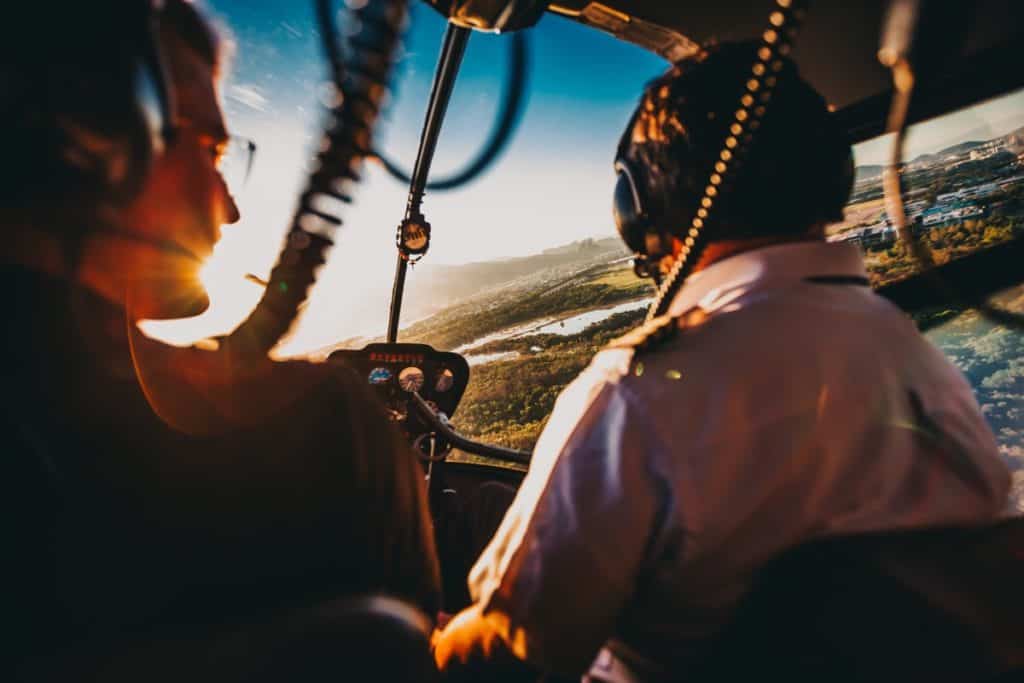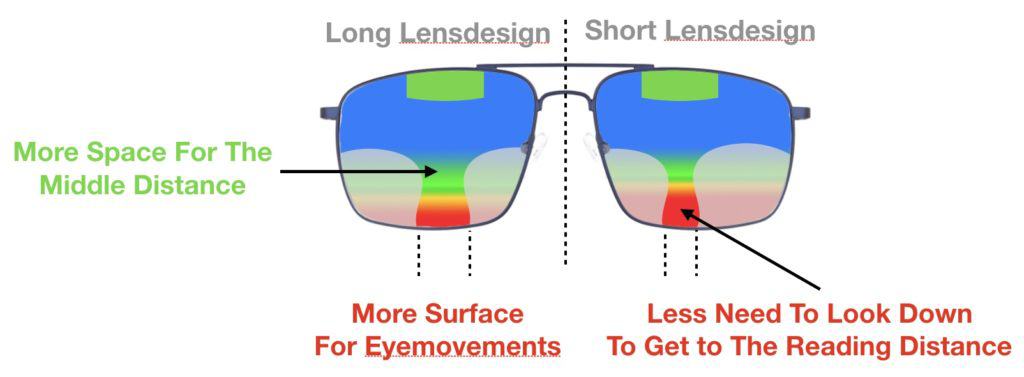Progressive glasses for pilots have distance vision and reading distance built-in in the middle to lower part of the lenses. But in addition to the normal progressive lens design, they add a bifocal window in the upper part of the lenses. This is how you can see clearly in near range in all parts of your cockpit.
Obviously, you only need these progressive lenses for pilots if you are operating in a cockpit that forces you to look up into the near distance. Whether you would benefit from this correction will be discussed in this article. There are times when to think about those lenses and times I would not recommend them. As with all Multifocal lenses you need to get used to moving your head in the direction you need to see sharp in. That requires a few days and a little motivation to get used to the lens design.
From pilot to pilot distances to the middle panel and your checklist may vary. This is why we highly recommend you measure all the relevant distances before you get your eyes checked and tell the optometrist the distances. We recommend noting the following down:
- distance to the overhead panel
- distance to paper or iPad
- distance to the middle panel
- distances to charts
Just measure everything before you buy progressive glasses for pilots. Because of a slightly different distance in the cockpit (that was gauged), your prescription may vary.

When Should I Use Progressive Lenses for Pilots?
If you are over 55 years old you probably can not focus on near objects just with your single vision lenses. What happens is the distance far away is really sharp while looking outside of the cockpit but it gets hard to adjust your eyes on the screens in front and above you. That is the perfect time to start with these lenses. They will give you the ability to focus on everything inside the cockpit as long as you move your head in the direction you want to see sharp in.
On the contrary, if you are a younger pilot and 42 years of age and you just bought your first vision aid for a close-range you can probably easily adjust your focus to the dashboard of the cockpit. Because your eyes are still able to adjust to the near distances. This ability will be gone in a few years but right now you would probably not experience any better vision with progressive lenses for pilots. But it needs to be tested if your eyes feel fatigued after a flight.
What Should You Avoid When Buying Progressive Lenses for Pilots?
The information you get during the flight is highly dependable on the screens in your cockpit. That is why we recommend staying away from a polarization feature because it could mess with the colors on the screens. Or in addition to that, it could appear that your screen is off although it is on you can´t see them with your polarization on.
Don´t try to save on the anti-reflective coating. You have a lot of little lights in your cockpit that could be mirrored from the back surface of the progressive lenses into your eye. So order your progressive glasses with a good coating.
What You Should Consider When Buying Your New Progressive Glasses.
The frame should be bigger than most normal glasses. We need the size to give you the proper height to make the different zones fit into the glasses. We recommend a minimum height of 40mm. But beware this general information may vary depending on how high or low the frame sits in front of your eyes. If the glasses sit really low so your pupils are close to the upper lens edge there might not be enough surface to fit the segment for your overhead panel into your progressive lenses.
As a pilot, you should consider a second pair of tinted sunglasses if light sensitivity is a thing for you. You are facing all the weather conditions sometimes in just a few minutes. In those cases, some pilots are better off to have a better contrast or less dazzling to hold their concentration in less than optimal situations.

I already advised you to measure EVERYTHING before you go to your optometrist. That is often easier said than done when it comes to the panels. especially for the overhead panel. In those cases, it is great if you have the option to get some adjustments afterward. Like to get the glasses a little bit higher or lower. But you only get this option if the frame has dedicated nose pads. Only those little metal parts will give you this option.
The lenses can be manufactured in a custom way. That means you can make the lens design longer so you have more space in the panel in front of you and below the window. This adjustment leads to more space in this distance. However, you need to look more down to get the full reading support in the lower part of the lenses if you choose longer progressive lenses.

The length of the lenses varies from 14-20mm in most cases. If you choose shorter lenses your middle distance will shrink a bit and the near zones get a little smaller in the right and left. Our experience shows that a pilot with an average body height should stick to progressive lenses with a medium length. A taller pilot should go with a longer design.
Me personally I would not recommend a smaller design to a shorter pilot. The middle distance is simply too small. The medium-length starts at 16mm and I just saw plastic lenses in this lens type.
Stretching the reading power of your progressive lenses over a little more distance is not the only way to get a bigger reading area. For example, you can get standard lenses that take an average value of how much your eyes converge while reading, how big the pantoscopic tilt is, and how far the lens sits away from your eyes. But frankly spoken, most people don´t have those parameters set.
Our faces are in fact seldom perfectly symmetrical. Custom lenses with an individual set of parameters are only manufactured for you. And they can make your vision generally easier. Because you get zones in your lenses that are as big as it gets with your prescription. And as you saw above in the pictures. The areas for sharp vision are not huge. So you better get them set as good as it can be instead of compromising your vision during a flight for a lot of hours.

The lower portion of the progressive lenses is not the only part that has different options. If you are looking above your head you are looking through a segment for near range vision. This segment is available in different shapes. Most progressive lenses for pilots come with a C28 shape you already saw above in the pictures. But you can also get a flat segment or a round segment.
If the already mentioned lenses were not the right fit for you there is another option. You could also choose to go with a double progressive lens. It features a continuous increase of reading power to the top and to the bottom and has the full support of distance vision in the middle. With those lenses, it is highly important to measure where you are actually looking through the lenses on top to see your overhead panel.

Those lenses can be highly customized to your needs but it always takes an inquiry to the manufacturer to ensure your wishes can be produced. Bigger reading-zones more space in the middle distance, a thinner material you name it. All the measurements definitely take their time.
Last but not least we have the most expansive option. In seldom cases, pilots order custom-made franklin lenses. They are made of two, three, or more parts of different lenses and will give you the widest fields of view in the near range. But they come with a drawback. With every segment, you add there is a visible line that comes with it.

Not every manufacturer gives you these possibilities. Most of them will deliver you a standardized design with a fixed segment for the overhead panel. One of the manufacturers that can optimize the lenses to the max is Ophthalmica and Kaps Vision in Rathenow, Germany.
This was a more specialized topic but as always it was a pleasure for me to write about one of my favorite topics.
I wish you a great day.
Michael Penczek
